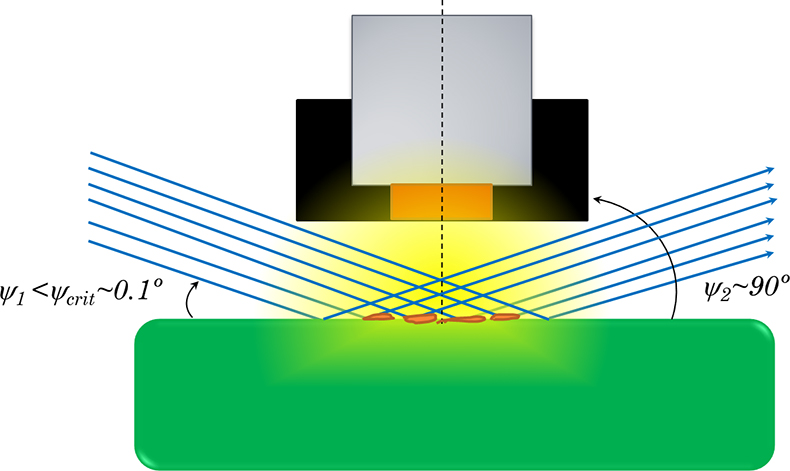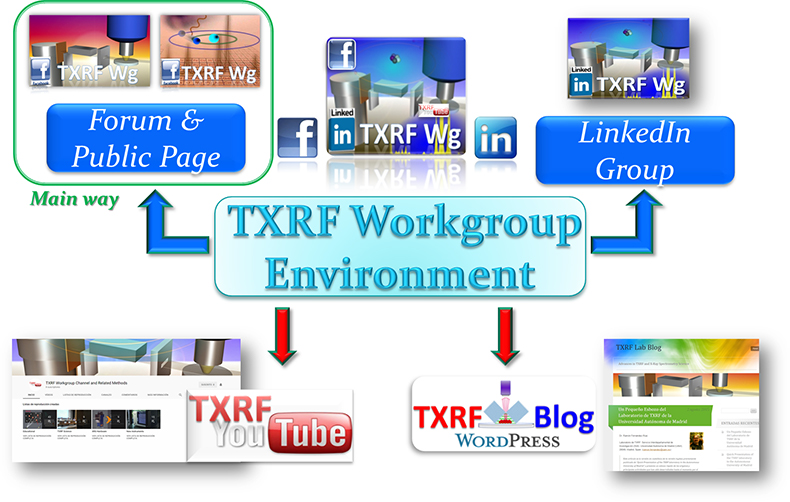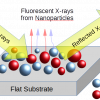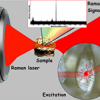Ramón Fernández-Ruiz
Laboratorio de TXRF, Servicio Interdepartamental de Investigación (SIdI), Universidad Autónoma de Madrid (UAM), 28049, Madrid, Spain. E-mail: [email protected], https://orcid.org/0000-0003-4769-3484, http://www.uam.es/sidi
Introduction
Total-Reflection X-Ray Fluorescence (TXRF) is an X-ray spectrometric technique which has developed from the classic energy dispersive X-ray fluorescence (ED-XRF). Perhaps because both techniques have sometimes been confused and thought of as equivalents, TXRF is little known or widely used when compared with other, more conventional, techniques such as atomic absorption (AAS) or plasma (ICP) spectroscopies. The geometric variation of the Source–Sample–Detector system, which differentiates TXRF from conventional ED-XRF, introduces drastic consequences in physical and analytical aspects. Figure 1 show the main geometrical differences of the ED-XRF and TXRF techniques.

Figure 1. Geometrical arrangement for conventional ED-XRF and TXRF. Ψ1 is angle of incidence and Ψ2 angle of detection.
The total reflection condition is obtained when an incident electromagnetic wave is completely reflected by a surface. This occurs for angles lower than a critical angle characteristic of the material of the reflector. Working in the condition of total reflection implies the generation of a field of X-ray standing waves (XSW) over the surface of the sample-carrier reflector, due to the constructive interaction of the incident monochromatic beam and the totally reflected beam. So, a sample deposited over the surface of the reflector, at first approximation, is excited twice, once by the incident X-ray beam and again by the reflected beam. This fact implies an amplification of the atomic X-ray fluorescence signals together with a simultaneous and drastic minimisation of the background (see Figure 2).1

Figure 2. Cross section around the surface of a reflector, showing the field of standing waves (XSW) triangular region and a sample deposited inside it.
As result, TXRF is a “micro-analytical” technique, because only small amounts of sample, around 0.1–10 µg, properly deposited inside the XSW region over the reflector are analysed. The sample is deposited in a thin layer with thickness between 0.1 µm and 10 µm, depending on the kind of material being analysed. Under these conditions, the matrix effects due to absorption and secondary excitation are negligible and the model of infinitely thin film can be applied. So, a simple linear relation between net intensity and concentration can be used. From the analytical point of view, this is by far the biggest advantage that TXRF has over conventional XRF. The TXRF elemental range includes the simultaneous detection of around 72 elements from Al (Z = 13) to U (Z = 92). Absolute detection limits are of only a few picograms for the great majority of the detected elements or, as relative detection limits, concentrations of few parts per billion (ppb) (µg L–1). As result, the relative sensitivities in TXRF have a universal character, regardless of the analysed matrix. This fact allows the use of the quick and easy method of internal standard addition as the usual way for multi-elemental quantification by TXRF.
The combination of low detection limits, multi-elemental character, microanalytical capacity, high sensitivity, low times of spectra acquisition and the ease of qualitative, mass proportions and quantitative analysis, open the field of the analytical application of TXRF to the research of metallic traces in all kinds of complex, and not so complex, systems. Besides that, TXRF has the ability to quantify any liquid or solid samples adequately suspended, without acid leaching, and by simply adding an internal standard and then depositing on an adequate reflector. This implies quick, low cost and no consumption of chemicals for TXRF analysis.2 In this way, TXRF is a technically consolidated spectroscopy which is more and more applied in very diverse scientific fields and different materials. Many applications of TXRF have been developed—for example, nanoparticle characterisation,3 catalytic processes studies,4 biomedicine,5 physics of materials,6 archaeometry,7 forensics,8 food,9 environment10 and many others. TXRF is a powerful tool, still to be discovered within the fields of biomedicine, metallomics and biochemistry as well as in materials, environment, analytical and food sciences.
The TXRF Workgroup
Given the relatively small base of TXRF spectroscopy, the TXRF Workgroup was created to act as a forum for current users and to broaden the usage of the technique. This article explores the aims of the TXRF Workgroup and is based on the invited talk given at the 15th TXRF Conference (TXRF2013) in Osaka, Japan.11 The TXRF Workgroup uses the power of Social Networks, increasingly present in our lives, for scientific communication, interaction and collaboration.
Present challenges for TXRF spectrometry
Considering my own experience in the field of TXRF,12 scientists and researchers are frequently influenced by three important factors: bibliography, personal experiences and external suggestions. Such influences can be a hindrance when new techniques, such as TXRF, are presented as an option. This impedes the development of new, alternative and even more appropriate analytical solutions that could be developed by TXRF. As a consequence, TXRF still remains largely unknown in scientific, academic and industrial sectors. So what challenges are holding back the development of TXRF? The first challenge facing TXRF is to try to widen an understanding of the analytical pros and cons of TXRF in the industrial and scientific sectors as well as within wider society. The second challenge can be found by analysing the number of scientific publications, with TXRF as a keyword, over time (see Figure 3).

Figure 3. Number of publications per year where the keyword “TXRF” is present in SciFinder.
As might be expected, following the commercialisation of the first TXRF instruments, from the late 1980s to 2000, the trend was upward, within understandable fluctuations, and indicated a promising future for the new spectrometry. However, from 2000 to now, the number of publications has stabilised at around 60 per year. So, the second challenge for the TXRF should be try to increase the number of scientific publications. The third challenge is related to the wide geographical dispersion of the TXRF community; TXRF needs to find a working environment where distances can be eliminated. The fourth challenge can be found in the small number of users of TXRF instruments around the world, especially when compared with other techniques such as ICP-MS, AAS or ICP-OES which have been adopted much more easily in the analytical academic, scientific and industrial world than TXRF. The TXRF community needs to try to increase the number of TXRF instruments in operation. Finally, the fifth challenge is related to the small size of its scientific community and, as a consequence, the small number of applications developed in the field of TXRF. Figure 4 shows the number of publications associated with some analytical techniques found for 2018 in the SciFinder database. Around 3962 contributions were published for ICP-MS, 1387 for AAS, 1059 for ICP-OES, 608 for LA-ICP-MS and “only” 89 for TXRF. So, we can see that researchers typically demand the analysis of their samples mainly by ICP-MS, ignoring the fact that TXRF could be an alternative and powerful analytical technique. So, the fifth challenge for the TXRF should be to try to increase significantly the number of applications developed and, more importantly, recognised under international accredited quality assurance norms (ISO, ASTM etc.). The first steps have already being taken in this direction by the TXRF community in the last few years.13 Recently, a European COST action (CA18130) was approved with the name “European Network for Chemical Elemental Analysis by Total Reflection X-Ray Fluorescence” (ENFORCE-TXRF). Its main objective is to introduce TXRF spectrometry in industrial, scientific and wider contexts.

Figure 4. Number of publications related with each one of the technique keywords during year 2018.
These challenges are significant, so what can we do? From my humble point of view, a first step to confront them can be found through the interrelation of very diverse disciplines and also by simplifying collaboration between TXRF professionals and with those of related techniques. In this way, even though the number of TXRF professionals are few, each one with limited resources and widely dispersed around the world, we can use the tools that social networks offer to share our resources and knowledge, and generate new knowledge. These ideas were the seeds that motivated me to create the TXRF Workgroup.
TXRF Workgroup description
Nowadays, the TXRF Workgroup is an open discussion and sharing platform where all people are welcomed regardless of their academic level, technological or scientific resources. Only one condition is required to become part of the group as a member, a clear interest in the TXRF-XRS area. One of the basic principles of the group is that the greater the diversity of its members, the higher will be the exchange of ideas between them and, as a natural consequence, the easier should be the generation of new knowledge—the main reason for the TXRF Workgroup. Facebook was the first social network platform we used due, mainly, to their approximately 2300 million users around the world and especially for its ease of use and ability to share digital objects. Today, LinkedIn, YouTube and a WordPress Blog can also be used by any member (see Figure 5). In Facebook, the TXRF Workgroup has two areas of interaction at different levels: a members-only area and a public one. The first, and most important, is the TXRF Workgroup Forum.14

Figure 5. Present structure of the TXRF Workgroup Environment.
This Forum is a restricted Facebook group which only previously approved members can access. Within this Forum it is possible to open lines of discussion, collaboration and/or communication for all members. Also, it is possible to share notes, pictures, articles, links, videos, comments, related news and events of interest, congresses, seminars etc. In parallel, there is a second interaction zone, known as TXRF Workgroup Public Page,15 which is the public face of the TXRF Workgroup. On this page, anyone can access the information published and where their “followers” are automatically notified of new publications. Recently, a YouTube Channel named the “TXRF Workgroup Channel and Related Methods” has been created.16 Currently, this contains approximately 43 videos related to all the aspects of x-ray spectroscopy. The idea is that all XRS professionals can suggest and, indeed, include interesting videos in this channel, whether ones they have produced themselves or are already on the Internet. Thus, XRS videos are available for study, as teaching material, as a way of sharing knowledge or even sharing users’ own experience in the XRS area. The latest addition to the TXRF Workgroup environment is the TXRF Blog,17 where all type of new contributions related with “Advances in TXRF and/or X-Ray Spectrometry Science” are welcomed.
Current status
Today, we have 169 members and the number is growing even given the perceived danger of social networks! In any case, today the TXRF Workgroup enables technicians, professors, PhD students, researchers, industrialists related to XRS, engineers and scientists from more than 53 countries to interact constructively and share their knowledge and even their instrumental and technological resources at a distance.
The TXRF Workgroup is an open way for professionals with common interests to connect, allowing the development of activities where international relationships are necessary. As examples, details of the last TXRF conferences—TXRF2013 in Osaka, Japan, TXRF2015 in Denver, USA, TXRF2017 in Brescia, Italy and the next TXRF2019 in Girona, Spain—have been publicised. Recently, an intercomparative Round-Robin study proposed by Dr Alex von Bohlen from ISAS-Dortmund (Germany) was coordinated using the TXRF Workgroup as the main communication channel for the TXRF participant laboratories around the world.
Outlook
Nowadays, the TXRF Workgroup is increasingly known by the international TXRF community. It is used to share information about new conferences, journals or related papers, however, the participation of the members is still not as frequent as it should be. Therefore, the main objective for the future is that the members of the group feel free to interact with any other concerning any question, proposal or collaboration related with this field. In particular, the following activities can be proposed as goals for the TXRF Workgroup:
- a way to help to solve local theoretical or practical questions related to the TXRF field of any member;
- a way to promote the analytical strengths of TXRF and its applications at all levels;
- a way to open new lines of collaboration for the development of new applications of TXRF in any field of knowledge;
- a way to promote the development of new technological and informatics improvements for TXRF instrumentation, collaborating with potentially interested companies related to TXRF;
- a way to generate employment opportunities for a specialist interested in TXRF and related techniques field and its applications;
- a way to collaborate and/or organise inter-laboratory activities in order to standardise the application of TXRF for a great diversity of matrices according to international standards and, finally
- a way to do all those things that we have in mind, but are limited by the resources we have available for their development.
To conclude, the number of members and their diversity is increasing and the first steps have been taken. Looking at the growth trend and the opportunities that the future offer, the outlooks are clearly promising and, more importantly, the future will depend mainly on the TXRF Workgroup community itself. Perhaps, in the short term, the most important opportunity for the TXRF community will be the application of the European COST action ENFORCE-TXRF (CA-18130) during the next four years (2019–2023). This COST action could involve the expansion of TXRF spectrometry, which can be a unique opportunity to add TXRF spectrometry to the pool of powerful, useful and versatile modern analytical techniques for industry, research and education.
References
- R. Klockenkamper and A. Von Bohlen, Total-Reflection X-ray Fluorescence Analysis and Related Methods, 2nd Edn. John Wiley & Sons (2015).
- R. Fernández-Ruiz, “Three empirical cases of the deposition morphologies influence in the analytical quality of solid suspensions measurements by TXRF”, Spectrochim. Acta B 64, 672–678 (2009). doi: https://doi.org/10.1016/j.sab.2009.05.028
- R. Fernández-Ruiz, R. Costo, M.P. Morales, O. Bomatí-Miguel and S. Veintemillas-Verdaguer, “Total-reflection X-ray fluorescence: an alternative tool for the analysis of magnetic ferrofluids”, Spectrochim. Acta B 63, 1387–1394 (2008). doi: https://doi.org/10.1016/j.sab.2008.10.017
- R. Fernández-Ruiz, F. Cabello Galisteo, C. Larese, M. López Granados, R. Mariscal and J.L.G. Fierro, “TXRF analysis of aged three way catalysts”, Analyst 131, 590–594 (2006). doi: https://doi.org/10.1039/b513508g
- T. Magalhães, A. von Bohlen, M.L. Carvalho and M. Becker, “Trace elements in human cancerous and healthy tissues from the same individual: A comparative study by TXRF and EDXRF”, Spectrochim. Acta B 61, 1185–1193 (2006). doi: https://doi.org/10.1016/j.sab.2006.06.002
- Q. Zheng, F. Dierre, V. Corregidor, R. Fernández-Ruiz, J. Crocco, H. Bensalah, E. Alves and E. Diéguez, “Deposition of nanometric double layers Ru/Au, Ru/Pd, and Pd/Au onto CdZnTe by the electroless method”, J. Crystal Growth 358, 89–93 (2012). doi: https://doi.org/10.1016/j.jcrysgro.2011.04.014
- R. Fernández-Ruiz and M. Garcia-Heras, “Analysis of archaeological ceramics by total-reflection X-ray fluorescence: Quantitative approaches”, Spectrochim. Acta B 63, 975–979 (2008). doi: https://doi.org/10.1016/j.sab.2008.06.004
- T. Ninomiya, S. Nomura, K. Taniguchi, S. Ikeda, “Application of GIXF to forensic samples”, Adv. X-ray Chem. Anal. 26s, 9–18 (1995).
- L. Borgese, F. Bilo, R. Dalipi, E. Bontempi and L.E. Depero, “Review: Total reflection X-ray fluorescence as a tool for food screening”, Spectrochim. Acta B 113, 1–15 (2015). doi: https://doi.org/10.1016/j.sab.2015.08.001
- L. Borgese, A. Zacco, E. Bontempi, P. Colombi, R. Bertuzzi, E. Ferretti, S. Tenini and L.E. Depero, “Total reflection of X-ray fluorescence (TXRF): a mature technique for environmental chemical nanoscale metrology”, Meas. Sci. Technol. 20, 084027 (2009). doi: https://doi.org/10.1088/0957-0233/20/8/084027
- R. Fernandez-Ruiz, Invited talk at the 15th International Conference on Total Reflection X-Ray Fluorescence Analysis and Related Methods (TXRF2013). Book of Abstracts, I26, 230–231 (2013).
- R. Fernandez-Ruiz, “XRF in IAEA”, XRF Newsletter, No. 27, 12–15 (2017).
- L. Borgese, F. Bilo, K. Tsuji, R. Fernández-Ruiz, E. Margui, C. Streli, G. Pepponi, H. Stosnach, T. Yamada, P. Vandenabeele, D.M. Maina, M. Gatari, K.D. Shepherd, E.K. Towett, L. Bennun, G. Custo, C. Vasquez and L.E. Depero, “First Total Reflection X-Ray Fluorescence round-robin test of water samples: preliminary results” Spectrochim. Acta B 101(1), 6–14 (2014). doi: https://doi.org/10.1016/j.sab.2014.06.024
- Restricted Facebook Group of the TXRF Workgroup Forum: http://www.facebook.com/groups/TXRFSpectrometry .
- Public Facebook Page of the TXRF Workgroup: http://www.facebook.com/TXRFSpectrometry.
- Link to the TXRF Workgroup and Related Methods YouTube Channel: http://www.youtube.com/channel/UCFqW6Tlu8VMOjFSjovHaqrw.
- TXRF Blog: http://txrfspectrometryblog.wordpress.com











